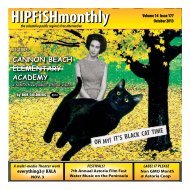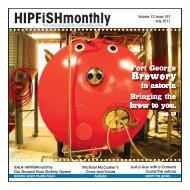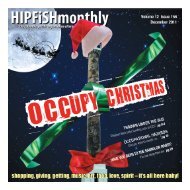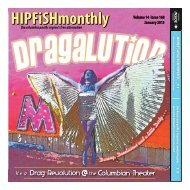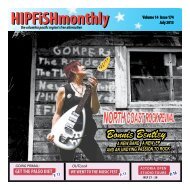HIPFiSHmonthly
HIPFiSHmonthly
HIPFiSHmonthly
- No tags were found...
Create successful ePaper yourself
Turn your PDF publications into a flip-book with our unique Google optimized e-Paper software.
A K-12 budget no one likes, ahighway renamed for a maneveryone respected, anda legislative process thatmay drive everyone crazy.Welcome back to the . . .2011 OregonLegislative sessionBy t.a. barnhartGood Bills moving to the SenateBill to link Community Colleges and UniversitiesA bill that creates a clear path for students to transfer betweencommunity colleges and universities passed the Oregon Houseunanimously. HB 3251, championed by Representative Val Hoyle(D-West Eugene/Junction City), earlier received unanimoussupport in both the Higher Education and Education Committees.The bill makes it easier to transfer credits from communitycolleges to universities, said Hoyle.Buy Oregon First Bill – HB 3000HB 3000 allows state agencies to choose Oregon goods whenbidding out contracts. The House passed HB 3000, the BuyOregon First Bill. The bill, chief sponsored by Representative BrianClem (D-Salem) and Representative Ben Cannon (D-SE Portland),allows state agencies to give preference to goods and servicesproduced in Oregon when bidding out contracts.“Oregon government purchases a lot of goods and services.We should be buying Oregon products first. We think as manyof these products as possible should be purchased from smallbusinesses within our state, particularly when the price of thoseThe Biggest Deal: K-12 BudgetIn April, the Senate and House passed,and Gov Kitzhaber signed, the K-12 budget(SB 5552). The $5.7 billion budget is,agrees every member of the Legislature,far short of adequate. But, as Sen BetsyJohnson put it, “We don’t have enoughmoney to fund everyone at the levelthey think is optimal.” The Senate voted30-0 for the bill, an extraordinary feataccording to Johnson.The vote in the House was 32-28;each caucus undoubtedly agreed whowould vote for and against the budget.The bill had to pass — too much wasriding on the need to pass this budgetearly, including continuing a goodworking relationship with both theSenate and the Governor — but asmembers on both sides of the aisle aspossible were allowed to vote No. RepDeborah Boone was one who eitherchoose, or agreed, to vote Yes. Her statementon voting Yes was almost identicalto that of Rep Brad Witt: this is themoney we have, and it’s not enough.But she will also be supporting efforts ofHouse Dems to tap more reserve fundsfor schools, an effort Witt also supports.Sometimes the politics forces thesekinds of results: Witt and Boone are inagreement on the K-12 Budget, but itwas her duty, or choice, to vote to passthe bill.In other LegislativeBUSINESS . . .Even after the passage of the K-12budget, which represents about onequarterof the state’s spending fromthe General Funding, budget mattersdominate. The state’s massive budgetgap, approximately $3.5 billion short ofwhat would be needed to fund existingprograms at existing levels (with inflation),means that policy matters won’tnecessarily pass on merit; everythingwill be scrutinized in unprecedentedways through the lens of funding.Johnson, who sits on the budgetwritingWays and Means Committeesaid, “We are going to be doing inhumanebudgets” in human services. Thestate, she said, may be pushing cuts tohealth providers of up to 19%. “A facilitylike Clatsop Care is in jeopardy; conceivablythe hospital is in jeopardy,” she said.Witt explained that for rest of budget,“much of this is a zero-sum game …we can’t spend the same dollar twice.”To exacerbate the problem, he said,many of the cuts will lead to the loss ofmatching federal funds: a $1 cut growsto potentially to a $6 or $7 loss.All three local representatives arecontinuing work on both legislation andconstituent service. Johnson noted therecent damage to the dock at the City ofWarrenton Wauna Mill and her efforts tocoordinate with state agencies to moverepairs forward as quickly as possible.Witt spoke about bills moving throughthe legislative process regarding jobs,noting efforts in alternative energy andfuels using biomass and even recyclingof plastic. He also has a bill that wouldmake the possession and sale of sharkfins in Oregon illegal, a ground-breakingbill that attacks the cruel practice ofshark-finning (cutting off the fins andthen returning the maimed fish backinto the sea to slowly die).Boone had a number of legislativesuccesses, including a bill to fix a holein the worker compensation that hadremoved podiatric care from the list ofapproved treatments; extending thesunset on wave energy rules beyond2022; and a series of bills that are movingforward as amendments to otherbills. These include bills on dangerousoperation of ATVs and an animal abuserregistry.Finally, the House passed HB 3354unanimously: this will rename a portionof Highway 30 between St Helens andRainier in honor of slain Police ChiefRalph Painter; the Senate will act on thisbill in early May.MayOn May 12th, the State Economist willrelease the “May Forecast” and, at thatpoint, all remaining budget bills willbegin to scramble for final funding. Apositive forecast won’t mean a suddenflood of money; even the rosiest forecastwill still be relatively grim for thestate. More likely is that additional fundswould be released from reserves withthe assurance those will be recoveredvia economic improvements. And thefact that the Leg will be back in sessionnext February means they can providenecessary adjustments to the 2011-13budget at that time.Meanwhile, as the month movesalong, committeeswill struggle to hear as many bills aspossible, to pass the most vital, and totry to avoid politically damaging votes.That won’t be easy. On May 11th, for example,the House Rules committee willhold a public hearing on Tuition Equity,allowing undocumented residents toattend Oregon colleges and pay in-statetuition. If that gets to the House floor, alot of Representatives are going to befacing a volatile decision.T. A. Barnhart is a regular columnist forBlue Oregon and legislative videographer.Look for coming video legislation updateonline at www.hipfishmonthly.comproducts is very similar. This bill allows Oregon companies totake advantage of the state’s purchasing power to grow theirbusinesses and create more Oregon jobs,” said Rep. Clem.Oregon House Passes Bottle Bill Update – HB 1036An improvement to Oregon’s iconic Bottle Bill passed out ofthe House on a 47-12 vote.“Just a shade over 40 years ago, this chamber passed HB 1036,Oregon’s Bottle Bill,” said bill sponsor Rep. Ben Cannon (D –Portland). “It turned out to be one of the most effective recyclingtools ever devised, but it’s showing signs of age. Today’s votehelps bring the Bottle Bill into the 21st Century.”HB 3145 updates the Bottle Bill by expanding the system toinclude containers for most juice, tea, and sports/energy drinks,no later than January 1, 2017.The bill also encourages the development of a robust systemof redemption centers, which will maintain consumer conveniencewhile improving the redemption experience. It creates anincentive for the beverage industry to keep the redemption ratehigh. Only if redemption rates fall below 80% after 2016 wouldthe deposit increase to 10 cents per container.New Beginnings.by bobgoldbergIn one week this pastApril, I celebrated Passover,Earth Day and Easter.Each holiday, in itsown way, is about newbeginnings. Passovercelebrates the liberationof the Hebrews fromslavery in ancient Egypt.Earth Day focuses onthe environment, andhow we can sustainlife on our planet. AndEaster is all about resurrectionand renewal.Spring is also acelebration of newbeginnings. The aboveholidays all celebrate the eternal cycle of life and death which is onthe rise in early spring. Here on the coast, we had our first inkling ofspring, with (relatively) warm and even sunny weather during theweek we celebrated the above holidays. Leaves are out or on theirway, flowers are blossoming, and the inevitable lawn mowers, weedwhackers and other power tools of choice made their way out ofwinter storage.This column is a new beginning for the occasional feature concerninginvasive species that has sprung forth on the pages of HIP-FiSH as recently as last month. Each month will feature news, viewsand history about invasive species and our continuing battle againstthem. The focus will be on the local scene, but the big picture willalways be kept in mind, and examples from other regions of thecounty and world will be shown to enhance the debate.And the debate is the essence of this column.Opposing views on invasive species will be presented, with asprinkling of skepticism and fact-checking. You’re invited to chimein on the HIPFiSH web page, http://www.hipfishmonthly.com/, withyour thoughts and comments.It’s probably appropriate to start out with some definitions.Perhaps the best definition I’ve seen of invasive species comes fromthe Invasive Species Definition Clarification and Guidance White Paper,submitted by the Definitions Subcommittee of the Invasive SpeciesAdvisory Committee (ISAC), in conjunction with Executive Order13112, issued in 2006:“Invasive species are those that are not native to the ecosystem underconsideration and that cause or are likely to cause economicor environmental harm or harm to human, animal, or plant health.Plant and animal species under domestication or cultivation andunder human control are not invasive species. Furthermore forpolicy purposes, to be considered invasive, the negative impactscaused by a non-native species will be deemed to outweigh thebeneficial effects it provides. Finally, a non-native species mightbe considered invasive in one region but not in another. Whetheror not a species is considered an invasive species depends largelyon human values. By attempting to manage invasive species, weare affirming our economic and environmental values. Those nonnativespecies judged to cause overall economic or environmentalharm or harm to human health may be considered invasive,even if they yield some beneficial effects. Society struggles todetermine the appropriate course of action in such cases, but in ademocratic society that struggle is essential.”Since invasive species are defined to be “not native”, a legal definitionof native species would be useful in our discussions. Accordingto USLegal.com, a native species is one that:“occurs naturally with respect to a particular ecosystem, ratherthan as a result of an accidental or deliberate introduction intothat ecosystem by humans. In the U.S., non-native species aretypically defined as those that arrived since the time of Europeancontact.”Armed with the definitions above, it’s pretty obvious that themost important invasive species in our area is Homo sapiens sapiens(since all of us living now arrived after 1492). But don’t let the invasivespecies councils know that one...Next month, we’ll look at some of the local projects to eradicate orcontrol invasive species, and their effectiveness. Welcome to Weed Wars!9 may11 hipfishmonthly.com



